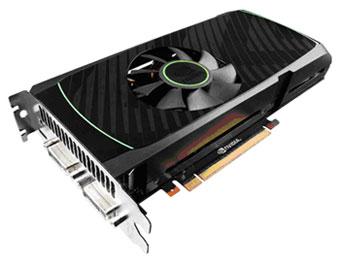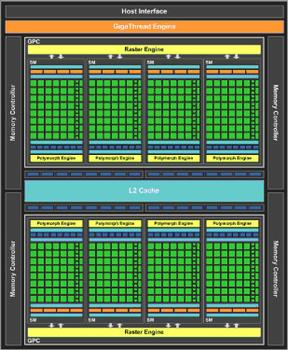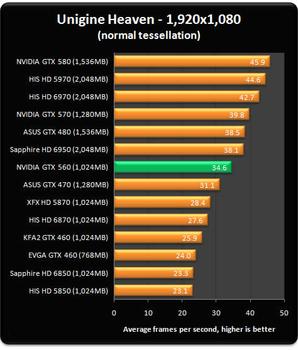The return of NVIDIA's Titanium
When it comes to GPUs, NVIDIA has been hitting all the right notes of late. In recent months, the high-end GeForce GTX 580 and GTX 570 have been well received, and the excellent last-generation GTX 460 continues to prove popular in the mid-range.
But there's clearly a gap between the GTX 570 and GTX 460, and NVIDIA is plugging that hole with the launch of the mid-to-high-end GeForce GTX 560 Ti.
Priced at around the £200 mark, The GTX 560 Ti is the first GeForce product to carry the Titanium (Ti) badge since GeForce 4 cards range almost a decade ago, intimating that NVIDIA believes this to be something a little bit special. The name's supposed to evoke feelings of strength, nimbleness, and plain awesomeness, so what exactly does the GTX 560 Ti bring to the table?
Flashback
Cast your memory back to the two-flavour GeForce GTX 460. While NVIDIA engineered a sweet price-to-performance ratio by debuting both the 1,024MB- and 768MB-equipped cards with competitive retail prices, the actual GPUs weren't as potent as the underlying Fermi architecture suggested.
You see, this is the GF104 die for the GTX 460 GPUs, and it comprises of what NVIDIA terms eight Streaming Multiprocessors (SM), each composed of 48 CUDA cores, making 384 in total. However, lower-than-expected yields and associated manufacturing issues resulted in each GTX 460 being issued with one deactivated SM, reducing the total number of CUDA cores to 336.
Fast forward 10 months and advances in manufacturing and improved yields have enabled NVIDIA to realise the full potential of the original GTX 460 design - and in the process, the GTX 560 Ti is born.
The new addition to the Fermi range
Making use of a new GF114 die, the GTX 560 Ti is composed of the same eight SM arrangement and general layout of the GTX 460's GF104 die, but this time the retail card gets to keep a full complement of hardware. This means a full 384 shaders, 32 ROPs, and a 256-bit memory bus, as well as improvements to enhance z-culling and much higher frequencies than their 4-series brethren.
Knowing that GTX 460 had plenty of overclocking potential, it's no surprise to see GTX 560 Ti shipping at higher speeds - but the numbers are nonetheless impressive. Standard core speed is set at 822MHz (up from 675MHz on GTX 460), whilst shader speed is bumped from 1,350MHz to 1,645MHz and effective memory frequency rises from 3,600MHz to a cool 4,008MHz.
| GPU | GeForce GTX 580 1,536MB | GeForce GTX 570 1,280MB | GeForce GTX 480 1,536MB | GeForce GTX 470 1,280MB | GeForce GTX 560 Ti 1,024MB | GeForce GTX 460 1,024MB |
| Transistors | 3.0bn | 3.0bn | 3.0bn | 3.0bn | 1.95bn | 1.95bn |
| Die size | 520mm² | 520mm² | 529mm² | 529mm² | 367mm² | 367mm² |
| Fermi revision | GF110 | GF110 | GF100 | GF100 | GF114 | GF104 |
| General clock | 772MHz | 732MHz | 700MHz | 607MHz | 822MHz | 675MHz |
| Shader clock | 1,544MHz | 1,464MHz | 1,401MHz | 1,215MHz | 1,645MHz | 1,350MHz |
| Memory clock | 4,008MHz | 3,800MHz | 3,696MHz | 3,206MHz | 4,008MHz | 3,600MHz |
| Memory interface | 384-bit, 1,536MB GDDR5 | 320-bit, 1,280MB GDDR5 | 384-bit, 1,536MB GDDR5 | 320-bit, 1,280MB GDDR5 | 256-bit, 1,024MB GDDR5 | 256-bit, 1,024MB GDDR5 |
| Memory bandwidth | 192.4GB/s | 152GB/s | 177.4GB/s | 133.9GB/s | 128.3GB/s | 115GB/s |
| Shaders | 512 | 480 | 480 | 448 | 384 | 336 |
| GFLOPS (FMA) | 1,581 | 1,405 | 1,345 | 1,089 | 1,264 | 907 |
| L2 cache | 768KB | 640KB | 768KB | 640KB | 512KB | 512KB |
| Texturing | 64ppc bilinear 64ppc FP16 | 60ppc bilinear 60ppc FP16 | 60ppc bilinear 30ppc FP16 | 56ppc bilinear 28ppc FP16 | 64ppc bilinear 64ppc FP16 | 56ppc bilinear 56ppc FP16 |
| ROPs | 48 | 40 | 48 | 40 | 32 | 32 |
| ROP rate | 37.1 | 29.3 | 33.6 | 24.28 | 26.3 | 21.6 |
| GTexel/s bilinear | 49.4 | 35.1 | 42 | 33.99 | 52.7 | 37.8 |
| FP16 rate | 49.4 | 35.1 | 21 | 17 | 52.7 | 37.8 |
| Board power (TDP) | 244W | 219W | 250W | 215W | 170W | 160W |
| HDMI | 1.4a | 1.4a | 1.4a | 1.4a | 1.4a | 1.4a |
The pertinent specifications, detailed above, suggest that the GTX 560 Ti will slot in alongside a previous high-end contender - GeForce GTX 470 - and the on-paper potential has been backed up by benchmarks from leading technology review sites:
Summary
NVIDIA's GeForce GTX 560 Ti graphics card builds on the success of the GTX 460 by using a revised die that's fundamentally more power-efficient. GF114's tweaks mean that it activates the dormant Streaming Multiprocessor - leading to more cores, tessellation, and texture units - and ramps up clocks on all fronts.
Priced at around £199 at launch, the GeForce GTX 560 Ti is undoubtedly one of the finest graphics cards ever released at under £200. It provides stiff competition to AMD's Radeon HD 6950 and should certainly be on your DX11 shortlist.










